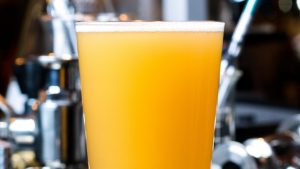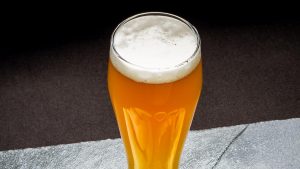Best Hefeweizen: Everything To Know About These German Beers
 Beer enthusiasts usually look for the best Hefeweizen at least once in their life as this German wheat beer is known for the delicious presence of banana and clove in its recipe.
Beer enthusiasts usually look for the best Hefeweizen at least once in their life as this German wheat beer is known for the delicious presence of banana and clove in its recipe.
Before diving into making your own Hefeweizen beer, you can check out some of the best choices from the top brands in the market.
Continue reading our complete review to know the best-rated Hefeweizen and other helpful information.
Best Hefeweizen Beer
If you want to try a bottle of hefeweizen beer, you should check out these top choices from the best hefeweizen brands.
– Live Oak Hefeweizen
At the top of our list is the Live Oak Hefeweizen from one of the leading breweries in Texas. It has an authentic German character, especially once you take in the scent. You will taste hints of spice and banana bread mixed with the bready, creamy malt foundation. It has an alcoholic content of 5.2 percent.
– Hofbrau Munchen Hefeweizen
The Hofbrau Munchen hefeweizen has a predominantly German style, but unlike others, you won’t see any big banana esters as you drink this. It has a dominant wheat malt taste with floral hops on the dank side, but you can still recognize that this is a hefeweizen because of the clove character and creamy mouthfeel. The ABV is set at 5.4 percent.
– Schlafly Hefeweizen
You can enjoy drinking this 4.1 percent ABV beer for a long time without getting too drunk. The Schlafly Hefeweizen has noticeable spicy and floral hops in its scent.
It is a brilliant blend of wheat beer and German-style pilsner, with a crisp taste and malt hops. It’s a pretty unique beer when compared to the other hefeweizens on our list.
– Weihenstephaner Hefeweissbier
Produced by the oldest brewery in the world, there’s no doubt that this classic Hefeweizen is on our list. The yeast notes are the most noticeable, along with the hints of clove spice, unlike banana. It features an overall bready wheat flavor and an ABV of 5.4 percent.
– Schlafly Raspberry Hefeweizen
This unique Hefeweizen will impress you with its explosive jammy raspberry taste that manages to combine this with the hefeweizen character. However, the raspberry flavor dries out immediately, probably because of the low 4.1 percent hefeweizen.
– Widmer Hefeweizen
The Widmer Hefeweizen is the perfect example of a famous beer as it has been around since 1986. The beer has a bread crust flavor that is balanced with lemon citrus. You will also notice the complex notes and hints of banana with each sip. This old-school beer is best for those who enjoy dry hefeweizen beers.
– Sketchbook Brewing Cumulus
This enthusiast hefeweizen features a faint aroma and taste of cucumber and lime. You will notice the tight carbonation of the Sketchbook Brewing Cumulus with each sip, and orange and tangerine notes are noticeable. It also has a quick-dry finish with a lingering orange taste.
– Andechser Weissbier Hell
The Andechser Weissbier Hell is another of the top Hefeweizen beers on our list, with unique aromas of shoe leather and citrus. You will enjoy the bread taste on the body, reminiscent of an orange-themed breakfast.
– Pinkus Hefe Weizen
The first taste you’ll have of this hefeweizen beer is bitter, but as you become accustomed to the Pinkus Hefe Weizen, you will start to taste its orange-lime sweetness. The hints of citrus fruits shine bright in this organic beer.
– Erdinger Weissbier
You can already enjoy the delicious aroma of honey malt when you bring the Erdinger Weissbier to your lips, but it’s even more pronounced in its taste. Although it’s a little bitter, you can enjoy the honey taste with each sip.
– 1623 Brewing Hefeweizen
Next on our list is the 1623 Brewing Hefeweizen, sporting a light and supportive body with lively carbonation. The yeast is apparent in the aroma with hints of lemon and orange. As for its taste, this beer isn’t strong in flavor and taste, although it is in terms of the ABV which is set at 5.6 percent.
– KC Bier Co.Hefeweizen
This Hefeweizen is described as a Bavarian-style wheat ale by the brewery, coupled with a complex flavor. You will perceive hints of citrus in the scent, while the taste has the usual banana and clove flavors with each sip.
There are also hints of spice with herbal and lemongrass flavors. The fruity aftertaste is combined with the bitterness from the yeast.
– Troegs Brewing DreamWeaver Wheat
The DreamWeaver beer is a bold hefeweizen with intensely balanced esters and phenols on the nose. The beer has a dry sip and a clean finish, giving you a drinkable experience. The mouthfeel is best described as soft and hoppy.
– Ayinger Brau Weisse
Enthusiasts who enjoy bitter and unique tastes will love reaching for the Ayinger Brauweisse. The scent is a strange mix of overripe fruit, sweetness and old milk, but when you take a sip, you can feel the carbonation. There are also subtle hints of lemon and lime.
– Widmer Brothers Hefeweizen
This Hefeweizen does not offer much in terms of the scent, but you can distinguish the American hops when you taste it. The taste goes towards bitterness, as the herbal hints overshadow the flavor of the yeast.
– Wektenburger Kloster Hefe-Weissbier
Enjoyed better when it’s fresh, this hefeweizen beer features fresh tobacco and tanned leather on the nose. As for its flavor, you can enjoy the tree bark, fruit and orange blend. This beer does not age well, so it’s best to look out for a fresh one.
– Pyramid Breweries Hefeweizen
When drinking this Hefeweizen from Pyramid Breweries, the first thing you’ll notice is the golden haze appearance. It features a light and thin body with a bready scent. You can enjoy the blend of orange and banana with each sip, especially when you drink it by the pint.
– Schneider Weisse Edel-Weisse
This Schneider hefeweizen has a spicy body with tastes of orange and grapefruit for a sweet flavor. It sets itself apart from the traditional Hefeweizen with its herbal tea scent and complex character.
– Westbound & Down Don’t Hassle the Hef
The unique name of this Westbound & Down hefeweizen isn’t the only good part of this American Hefeweizen. The beer focuses on citrus fruitiness, which you will definitely notice with each sip and whiff. It has a bitter finish, and the delicious citrus zest aftertaste keeps you wanting more.
– Squatters American Wheat Hefeweizen
Last but not least, the final Hefeweizen on our list is the Squatters American Wheat beer, which has a tangy and soft wheat taste. It’s a bit thin and light in its body, and there are no yeast esters, making it more drinkable.
What Is Hefeweizen Beer?
Hefeweizen is a German white beer or “weiss beer” in German. It translates into “yeast wheat,” which is the central part of the recipe. Most hefeweizen beers also have intense aromas and tastes of clove and banana, and sometimes, you will notice vanilla and bubblegum.
This beer is characterized as ale since it’s made with the top-fermentation method and usually has a low to moderate ABV, set at up to 5.5 percent. It also features a cloudy appearance because of the suspended yeast and a crisp, drinkable character.
Hefeweizen is often mistaken for witbier and American wheat beer, but there are noticeable differences among these three.
General Hefeweizen Tasting Notes
 Even when drinking the popular hefeweizen beers, you will notice that they all feature similar tasting notes that classify them as hefeweizen beers. The pale beer is known for its high carbonation, cloudy mouthfeel, dry finish, and banana-clove character from the aroma to the taste.
Even when drinking the popular hefeweizen beers, you will notice that they all feature similar tasting notes that classify them as hefeweizen beers. The pale beer is known for its high carbonation, cloudy mouthfeel, dry finish, and banana-clove character from the aroma to the taste.
Appearance
Hefeweizen beers usually have a pale appearance, going from straw to gold. The thick head features good retention and a smooth taste. The haziness in the appearance depends on the brewery, and it doesn’t look like a standard unfiltered beer because of the wheat.
Scent
As for the aroma, the Hefeweizen beer combines phenols, the clove, with fruits like bananas. The balance and intensity of these two can differ based on the brewery, but it is usually present in the aroma, especially with German-style Hefeweizen.
There’s barely any hops character, and you can perceive hints of wheat, which sometimes smells like bread crust. In some cases, the aroma can include vanilla and bubblegum, but this is always subtle.
Mouthfeel
Hefeweizen is generally known for having a medium-light to medium body mouthfeel. There’s no heavy body, although the yeast might deceive you. Because of the wheat, you will enjoy the creamy and fluffy nature of the body, which gives it a full and carbonated character.
Flavor
The flavor of this beer is mostly a combination of the soft bready or grainy flavor acquired from the wheat combined with the moderately strong clove and banana flavor. This gives a balanced and prominent taste such that other flavors become subtle. For instance, vanilla and bubblegum can add a slight sweetness to the beer, but it’s not dominant.
There’s nothing much to expect in the hops, so there’s a low level of bitterness. If you’re not a fan of bitter beers, then you will enjoy the taste of Hefeweizen.
This doesn’t mean it’s sweet either; it’s considered sweet because of the absence of bitterness, but too much sweetness will affect the taste. It finishes dry with a flavorful palate.
German vs. American
Although the German Hefeweizen is the original one, it was brought to America by immigrants. It later became more popular in America, leading to the creation of the American-style Hefeweizen.
The American-style Hefeweizen is more limitless than the German counterpart, so you can get various flavors depending on the one you buy.
Americans also use American yeast and more hops, making it maltier than the German type. German brewers use little or no balls in their Hefeweizen and put in more wheat than the Americans.
Homebrewer Recipe for Hefeweizen Beer
If you want to try making Hefeweizen beer in your home, you can follow the detailed recipe below.
Malt/Grain Bill
- 6 pounds of liquid wheat malt
- 1 pound of wheat dry malt extract
Hops Schedule
- 25 ounces of Hallertau at 60 minutes boil
Yeast
- 12 Danstar Munich Wheat Beer
Other Ingredients
- 7-10 ounces of cornstarch for priming
Directions
- Mash the grains until it becomes a wort.
- Follow the hops schedule.
- Return the wort to boil for 60 minutes.
- Add the dry wheat malt extract at 15 minutes to the end of the boil.
- Cool the wort to 45 – 55 degrees Fahrenheit.
- Aerate the wort and pitch the yeast.
- Leave to ferment in a warm dark place, with a temperature between 65 and 75 degrees, for one to two weeks.
- Bottle the beer and use the corn sugar for priming.
- Put it in the refrigerator to chill, and you can enjoy it cold.
Drinking Hefeweizen Properly
If you already like Hefeweizen, you might find it delicious regardless of how you drink it, but you can enhance the taste by drinking it the proper way. For one, you should pour it in a tulip glass, which is a glass that starts narrow, opens wide in the middle, and closes back to narrow at the top. This gives it the perfect head retention.
When pouring the beer, place the glass at an angle towards the bottle or tap and slowly pour the beer in. Wait for the head to reach the rim of the glass, and once it settles, you can swirl the remaining beer in the bottle. This will liven up the yeast, and you can pour the rest of the beer into the glass.
You should also drink the hefeweizen cold if you want to get the most out of its flavors, around 45 degrees Fahrenheit is the ideal temperature. It would be best to also rinse the glass in cold water before pouring.
Many people add a lemon slice to their Hefeweizen if they’re interested in garnishing, although others will argue that this ruins the beer’s original taste. On the other hand, enthusiasts think the tart flavor of lemon goes well with Hefeweizen.
Hefeweizen vs Wheat Beer vs Witbier
American wheat beer is made with clean American yeast and is different from Hefeweizen as it lacks the banana and clove character. It also lacks the spicy and fruity nature of witbier. Instead, American wheat beers have noticeable hops with a crispy taste and appear clear or cloudy.
Witbiers have a long history dating back to the 14th century in Belgium. They typically feature spices like citrus and coriander, which complements the bread and wheat.
These two beers are different from the wheat-yeast character the hefeweizen beer is known for.
Food Pairings With Hefeweizen Beer
Because of its comprehensive flavor profile, you can match the hefeweizen beer with a wide range of food, including German cuisine. These include apple strudel and weisswurst, but you don’t have to eat fancy food as this beer also goes deliciously well with pizza, smoky pork, salad and seafood.
You can try your Hefeweizen with smoked food, barbecue, beets, goat cheese, stroganoff, spicy dishes from Mexico and India, or herbal dishes with mint or rosemary. It can also be paired with desserts, especially when having something fruity like lime pie, banana bread or fruit cakes.
You can also enjoy drinking this beer with berries and other fruits.
History of Hefeweizen
Hefeweizen is one of the beers with a long history, dating back to the 1520s. It originated from Bavaria in Germany and has gone through different hard times since then. Despite this, it remains well-known and well-loved today.
The beer faced its first challenge in Germany when the Purity Law was proposed in 1487. This law stated that only barley, water and hops were allowed to be put in beer, and since the main ingredient for Hefeweizen is yeast, it was not included.
This law was focused on giving bread makers who wanted to expand into beer brewing access to inexpensive ingredients and also aimed to prevent the use of concoctions in preserving beers. Even foreign beers could not be imported in Germany during this time.
This situation led to breweries fighting back, resulting in the creation of Weissbier, another popular type of beer. But by the 1700s, Hefeweizen became more popular, especially with the comeback of dark lager.
As it became more popular, the laws changed to eventually allow Weissbier, but this didn’t make it popular again. The focus of the people had shifted to Hefeweizen, and it remains this way until current times. This German beer has become even more popular throughout the years, and you will also find American-style hefeweizen beers today.
FAQ
1. Is Hefeweizen a hoppy beer?
No, Hefeweizen is not typically considered a hoppy beer.
2. What is the difference between a Hefeweizen and a wheat beer?
Hefeweizen is a specific style of wheat beer that originated in Germany and is brewed with a specific yeast strain that gives it its characteristic banana and clove flavors. Wheat beer is a more general term that refers to any beer that is brewed with a significant amount of wheat in addition to barley. While all Hefeweizens are wheat beers, not all wheat beers are Hefeweizens.
3. What beer is similar to Hefeweizen?
Belgian Witbier or American Wheat Ale are similar to Hefeweizen, both being light, refreshing and brewed with wheat.
Final Notes: Try Out the Best Rated Hefeweizen!
 Now’s your chance to pick the top-rated Hefeweizen from our list and give this popular beer a try. You can dive into other brands or even make your own if you enjoy it.
Now’s your chance to pick the top-rated Hefeweizen from our list and give this popular beer a try. You can dive into other brands or even make your own if you enjoy it.
- Hefeweizen is German for yeast wheat, which is the main ingredient of the beer.
- The German-style beer is different from wheat beer, witbier and American Hefeweizen.
- It originated in the 1520s in Germany and regained its popularity in the 1700s.
- The best-rated hefeweizen beer on our list is the Live Oak Hefeweizen.
- Hefeweizen has a straw to gold appearance, with wheat, banana and clove taste notes.
- There is a low bitterness level because of the low hops and moderate ABV.
- You can make Hefeweizen in your kitchen with homebrewing recipes.
- It is best consumed cold in a tulip glass, and is sometimes served with a lemon wedge.
- It goes well with different food including smoky, spicy and herbal dishes.
Check out the Live Oak Hefeweizen beer and other recommended choices on our list!






